Producing a 'B' rig for the
Phantom
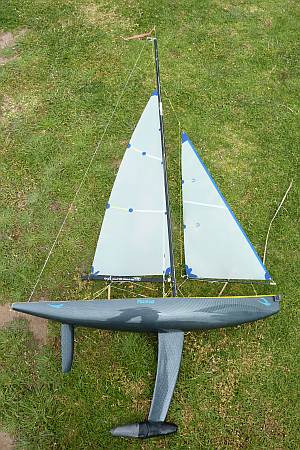
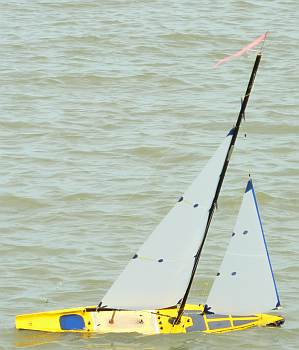
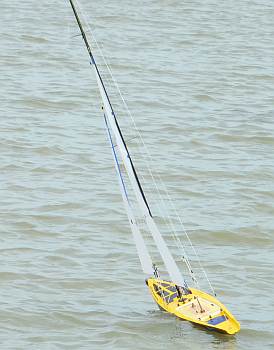
These sails certainly allow the Phantom to sail
in conditions where normally the yacht would wallow and be very
difficult to control. The yacht is sailable to 20+ knots
and under control at all times. The rig suffers against
the full rig in winds below about 8 knots - holds its own at 10
or so knots and starts to become a winner above that.
The members have now produced about 15 'B'
rig sails for the Phantom. These are about 75% of the area
of the standard rig with their average area much lower than the
standard rig and allow the phantom to sail in winds up to about
18 knots or so. Note that in keeping with the
specifications of the sails for the phantom, no seams are used
just a flat sheet of Mylar film (50 micron). The
dimensions of the sail are based on the standard rig with the
foot of both main and jib being about 10 mm less than the
standard rig and the luff measurements 75% of the standard rig.
I will give these dimensions more accurately soon.
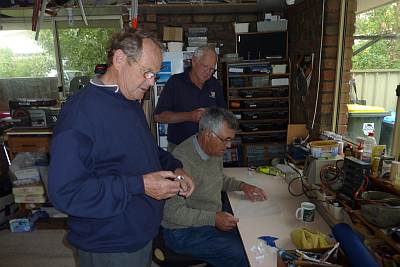 The process of producing the sails involved
drawing out the shape of the sails on stiff paper, taping this
to a bench and laying the sail cloth over the outline,
transferring the outline to the Mylar film other than the luff
then drawing a curved luff with a flexible wooden stick.
The luff curve was made about 5/6 mm for the main and about 3/4
mm for the jib. These correspond to the accepted value of
about 0.5% of the luff length (assuming a mast which is not very
flexible). See
photos in 'Images' menu
The process of producing the sails involved
drawing out the shape of the sails on stiff paper, taping this
to a bench and laying the sail cloth over the outline,
transferring the outline to the Mylar film other than the luff
then drawing a curved luff with a flexible wooden stick.
The luff curve was made about 5/6 mm for the main and about 3/4
mm for the jib. These correspond to the accepted value of
about 0.5% of the luff length (assuming a mast which is not very
flexible). See
photos in 'Images' menu
The luff is taped with 8/10 mm Mylar tape on
both sides while the foot and leech taped with 4 mm Mylar tape
on one side.
This helps prevent the Mylar film from tearing, supports the luff and
help develop a little shape in the sail when the leech tape
shrinks on release ever so slightly.
The result is a set of sails that are
aerodynamically clean and efficient. This is evident by
the way the Phantom continues to drive in the stronger gusts yet
remain competitive against the original sails to 8 knots or so,
becoming clearly more effective above 10 knots.
See Photos and videos of 'B' Rigs in action
in gusts over 20 Knots at
https://picasaweb.google.com/114231195882915542478
and find album 'Phantom B Rig in action'
Attaching the sails for quick change
I will outline methods of rigging these sails
below to make sail change quick and easy. The key thing
here is to make the change of sail easy to do so it can be done
quickly. This means that the sails need to be able to be
removed and replace readily and maybe the jib sheets attached
easily.
Looking at the mainsail first it makes sense
to leave the boom where it is and have an easily removed clew,
tack and head attachment. Richard's clew attachment is the
simplest (see clew/tack adjustment heading at top of page) while
Ben's method see same page is also fast and give complete
adjustment. The tack is easy as the original line will
work tho again Ben has a way to improve this at least for speed
of changing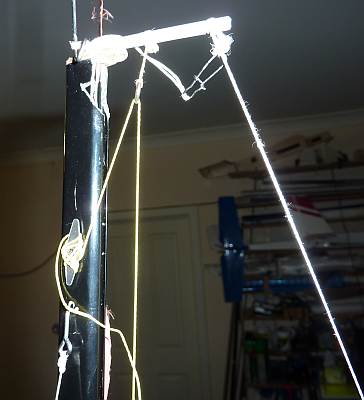 .
.
The head also can use the original
phantom method tho feeding the line through the small hole on
the fitting is fiddly. A small permanent ring attached to
this point can make it easier to feed the cord through.
Feeding the sail with its slides into the sail track requires
either removal of the masthead fitting or perhaps better, filing
away the top 12-15 mm of the track from the mast so the sail
slides can be fed into the track without removing the masthead
fitting (and rigging!). see picture at right
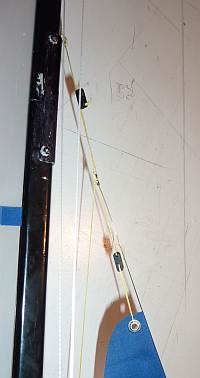
The jib is most easily set up on a new
separate boom. An arrow shaft or carbon fibre tube from
model suppliers (~6mm is best) is the best option. In this
way, the sail can be permanently setup with tack and clew
adjustments similar to the ideas in. The forestay needs
attaching to the mast using a hook in a 1mm hole somewhere just
above the mast joiner. The jib sheet attachment is most
easily done by making a loop in the end of the sheet and having
a sliding fishing fitting attached by a short strop to the boom
using a cable tie. See the clew/tack adjustment pages for
images and more description.
page
last edited on
04/05/2025